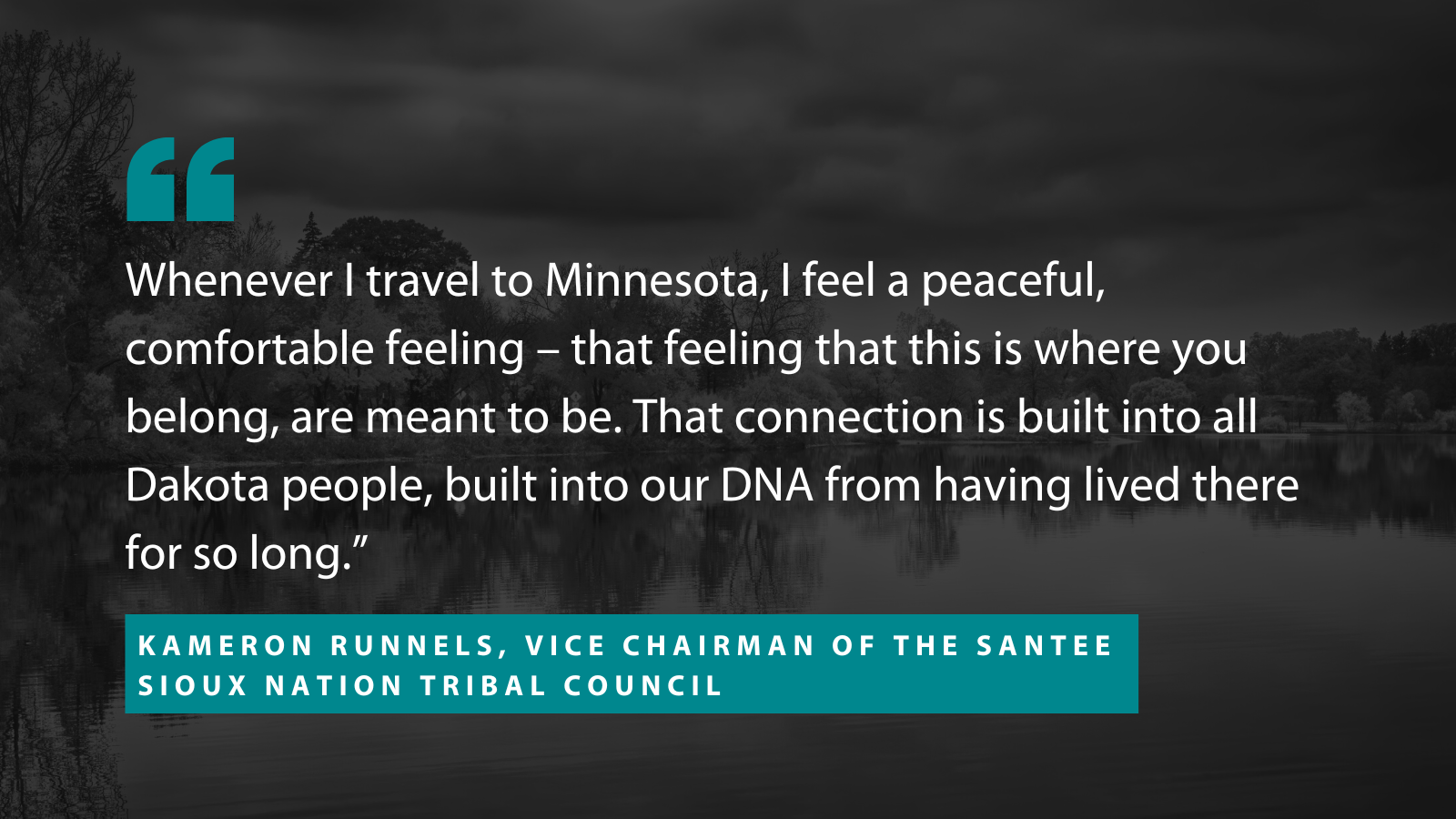
The Improve Group’s office in St. Paul is located on land that belongs to the Wahpekute Band of the Dakota Nation. The State of Minnesota and U.S. government stole this land through ethnic cleansing and forced removal.
The Santee Sioux Nation is the current home to many descendants of the Wahpekute Band of the Dakota Nation, on whose land our office is located. Kameron Runnels, Vice Chairman of the Santee Sioux Nation Tribal Council, kindly gave his time to review our land acknowledgement. He also answered questions in an interview with Improve Group Chief Practice Officer Becky Stewart. Check it out below.
This is the first of a series of newsletter articles sharing Kameron’s responses to our questions. In this article, Kameron tells us about the Santee Sioux Nation’s historical and continued connection to these lands.
Interview with Kameron Runnels, Vice Chairman of Santee Sioux Nation
Kameron Runnels, elected in November 2021 to the position of Vice Chairman of the Santee Sioux Nation, was interviewed by Becky Stewart in May 2022. We have been connecting with and learning about the Wahpekute and the Santee Sioux Nation more in the past year, and this conversation is part of that journey.
Question: We have begun learning more about the history of what is now the St. Paul/Minneapolis area. We know these are the traditional lands of the Wahpekute band of the Dakota. What can you tell us about the historical and continued connection the Santee Sioux Nation have to these lands?
Answer: Our people have lived on this land for centuries, perhaps longer. We originally lived in the big woods of northern Minnesota. When you look at old pictures, you will see a lot of Dakota people will have floral pattern in art or beadwork, with the patterns representing the woodland area. We were centered around Mille Lacs; this was considered our birthplace, where we were created. Our origin stories say that we emerged from under the lake. Santee, pronounced Isanti, is a reference to “under the knife,” or perhaps interpreted as under Knife Lake, or it could be interpreted from having battles with Ojibwe people who were our traditional enemy for centuries, meaning we were under the knife from them. We were pushed south by the Ojibwe until we settled in the southern half of Minnesota where we established villages all across Minnesota. Our ancestors are buried there. We have a burial site almost in the cities of St. Paul and Minneapolis.
The majority of Santee people today are Mdewakanton (Spirit Lake) and Wahpekute (Leaf Shooters) people. A group of Wahpekutes, led by Inkpaduta, had set out in the late 1850s on war path--actions that he and his followers did in response to his family being killed. This group of Wahpekutes set out killing settlers, farmers, and attacking villages in the late 1850s. During that time the other Dakota bands in Minnesota were told they needed to help hunt down this group, or all Dakota would be held responsible for Inkpaduta’s actions. Little Crow, who was our spokesman and chief at that time, set out with some of warriors to try and track down the ones responsible for the hostile actions against the whites. Little Crow never found them. Later, Inkpaduta and his followers fled west. It was told to me that his people and warriors were present when the Battle of Little Bighorn took place in Montana in 1876. Stories tell that the Santee band was there during fight with George Armstrong Custer at Little Bighorn. The Dakota present at that battle could have also come from fleeing Minnesota after the Dakota War of 1862, in which all Dakota were forcibly removed through the Dakota Removal Act, which made it illegal for us to live or enter the state. Our ancestors scattered everywhere after the 1862 war and many fled west and settled with our relatives the Lakota people.
Neighbors: Join us in paying land tax
All of us at The Improve Group would like to thank Vice Chairman Runnels for his partnership – from providing guidance in our first estimated land tax effort to reviewing our land acknowledgement to doing this interview. We deeply appreciate his engagement and are honored to have this connection.
As the Native Governance Center states, its important to “go beyond land acknowledgment” to take action to support Indigenous communities. To go beyond acknowledging we are on Wahpekute land, The Improve Group this year began paying a voluntary land tax to the Santee Sioux Nation. At the end of 2021, we paid $6,000.
As part of the process of learning about land acknowledgements, we understood that these statements are only the beginning of our responsibility to acknowledge our role in injustice and work toward a more just future. One step we identified was to pay the equivalent of our property tax to the Nation whose land we are on. Last year, The Improve Group began estimating our annual property tax (our share of the property’s tax since we rent part of a building) and paying this amount to the Santee Sioux Nation in acknowledgement that we are on Wahpekute land. We invite our neighbors to do the same. Payments can be made to:
Santee Sioux Nation108 Spirit Lake Ave. WNiobrara, NE 68760
Check back next month for the next part of Kameron's interview
In future articles, Kameron will share what he wants folks to know about the Santee Sioux Nation right now, how those living on his traditional lands can best support the Nation, and advice for people seeking to learn more about the past and present of his Nation. We will send this out with our next newsletter in January!
